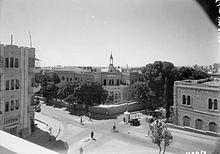Evangelical Deaconess Hospital (Jerusalem)
| Evangelical Deaconess Hospital בית חולים לדיאניות פרוטסטנטית Bikur Cholim Hospital |
|
|---|---|
| Sponsorship | Diakonia |
| place | Jerusalem |
| Country |
|
| founding | 1894 |
| Website | |
The Evangelical Deaconess Hospital in the Israeli city of Jerusalem , also known as the German Hospital , was an institution of the Kaiserswerther Diakonie . It is located on Prophet Street ( Rechov haNeviim ) and Straus Street and is now part of the traditional Bikkur Cholim Hospital complex , which is across the street.
History and description
Since 1888 the Jerusalem evangelical pastor Carl Schlicht had collected money for the construction of a hospital in the new town. In 1890 a piece of land was acquired by the Frutiger bank . Ernst Schwartzkopf & Heinrich Theising (Berlin) planned the building, which was carried out by Theodor Sandel between 1892 and 1894 . It was inaugurated in July 1894. Above the main portal you can see the symbol of the Kaiserswerther Diakonie, a dove with an olive branch, also above the side entrance, and there also the words "I am the Lord, your doctor" ( Ex 15.26 LUT ) in German and Arabic.
The building had an L-shaped floor plan. Access was from the main entrance on the corner. Opposite the entrance was an octagonal hall, to the left and right a corridor opened into one of the two wings of the building, which opened up the individual hospital rooms and received its light from the end of the corridor. There were four sickrooms with three beds in each wing. The operating room was upstairs above the entrance hall and the chapel opposite, above the octagonal hall on the first floor. The hospital was made of stone with an iron girder structure and had flat roofs.
Up to 100 patients could be admitted here, and a large garden around the hospital should ensure a pleasant atmosphere. During his visit to Jerusalem in 1898, Kaiser Wilhelm II donated money for the establishment of a modern operating room and for the water pipe.
During the First World War the hospital served as a military hospital, then as an English civil hospital, and it was not until 1923 that it was again run as a deaconess hospital. After modernization, it now housed an interior, a gynecological and a surgical department.
The Jerusalem NSDAP -Ortsgruppenführer and Templars Ludwig accountant suggested in the 1930s selling the device to the Bikur Holim Hospital, because the majority of patients are Jews. In 1937 the magazine Der Armen- und Krankenfreund reported that the deaconess hospital would move to the building of the Auguste Viktoria Foundation on the Mount of Olives . At the current location one suffers from the traffic noise and is "an island in a Jewish sea."
After the founding of the state in 1948, the civil military hospital was housed here.
Web links
Individual evidence
- ↑ a b c d Jakob Eisler: In the footsteps of the Germans in the west of Jerusalem. A stroll through the Prophet's Street (Ha-Nevi'im) in Jerusalem . In: Wolfgang Schmidt (Hrsg.): Community letter foundation journal (Evangelical community in German language in Jerusalem) . No. 1 . Jerusalem 2018, p. 25 ( evangelisch-in-jerusalem.org [PDF]).
- ↑ Some Foreign Hospitals in Jerusalem . In: The Hospital . June 22, 1918, p. 252 , PMC 5239433 (free full text).
- ↑ Gil Yaron: Jerusalem: A historical-political city guide . 2nd Edition. CH Beck, Munich 2007, ISBN 978-3-406-60167-5 , p. 260 .
- ^ Heidemarie Wawrzyn: Nazis in the Holy Land 1933-1948 . Walter de Gruyter, Berlin / New York 2013, ISBN 978-3-11-030629-3 , p. 80 .
Coordinates: 31 ° 47 '2.9 " N , 35 ° 13' 7.8" E


